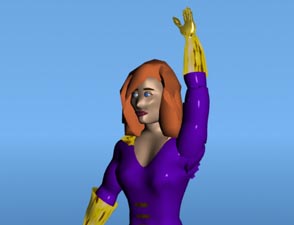|
|
|
GALLERY CONTINUED
PAGE TWENTY

Does anyone else remember anamorphic squeezing? Before movies used the 70mm widescreen format, they used to use a special distorting lens on the theater projector. My guesstimate shows that the lens used on the second picture results in an anamorphic squeeze of 200%, the same used for most anamorphic motion picture systems.Here is a copy of the lens, and here is the surface with a refractive index of 2.0; "Trace Refraction" will need to be activated in the Render panel.Creating the lens is a simple matter of Boolean subtraction of two cylinders from a box, in case you would like to do this yourself (and your version will probably be sharper). Increase or decrease the squeeze by "stretching" the lens or changing the refractive index of the lens surface. The character is based on the Hurrican Comic book character "Chassis McBain" by Bill O'Neill.
Anamorphic squeezing is still a common practice for shooting big special effects films until digital cinematography "arrives." I do not know how common it is in special effects, where the widescreen shape is used until the finished effects are "scanned." Look on it as an option in case you want to produce 8000 x 8000 images that can be projected on the big screen as virtual 16,000 x 8,000 widescreen.
One other kooky possibility for INSPIRE3D users: shooting 640 x 480 image sequences, for blow-up to 720 x 486 widescreen DVD! The actual conversion will have to be done in an editing program like LIGHTWAVE, but one can write the Scene and Object files in INSPIRE for the finished image sequences to have them ready for 3 second per frame rendering. This is why I don't drink real coffee.
The camera and lens were parented to a Null, and the lens was then sized and moved to an optimum position with edge transparency set to transparent to be thorough. (Edge transparency produces some interesting multi-image render processing.) It was discovered that trace refraction bizarrifies any polygonal inconsistencies, so it requires TRIPLING object polygons, or the object may have background elements peek through it.
The common sense approach is probably to save the scene file and do the renders in LIGHTWAVE. If you really MUST see what your animation looks like in widescreen, compose (or crop it using the Images panel "Image Sequence" button and a front-projected 16:9-shaped card in front of a black background) for a 640 x 360 render. The easy way to "anamorphose" this image sequence is to drop it into the Effects panel "Compositing" "Background Image" requester. It will automatically reshape the frame to fit the 4:3 defaults. Select 640 x 480 and let it rip. (This can also be achieved by Planar projection with a .75m size in the x direction.) I do not kow DVD formatting requirement well enough to know if this render would have any value for DVD work.
Anybody for a 16,000 x 8,000 animated classic set in distant space, about a space mermaid who is betrothed to a boor, until she is swept away to a space station controlled by a hideous beast with excellent manners?
All contents copyrighted Scott Lee Tygett c. 2000
< BACK . . . . . . . . . . . . . . < HOME > . . . . . . . . . . . . . . NEXT >